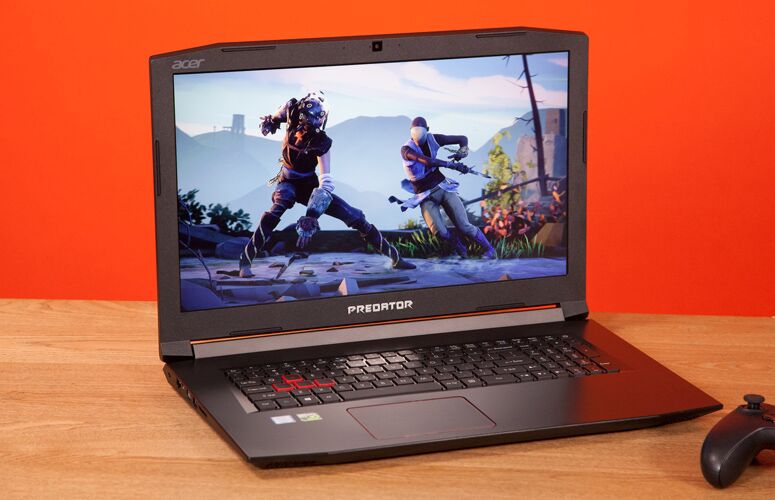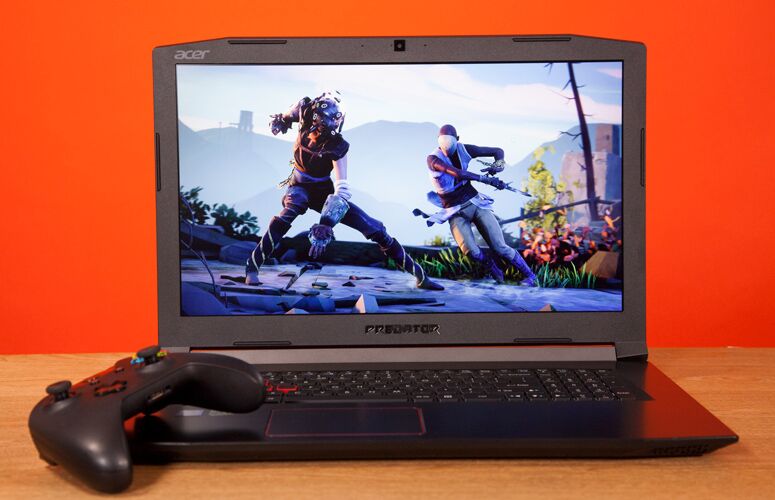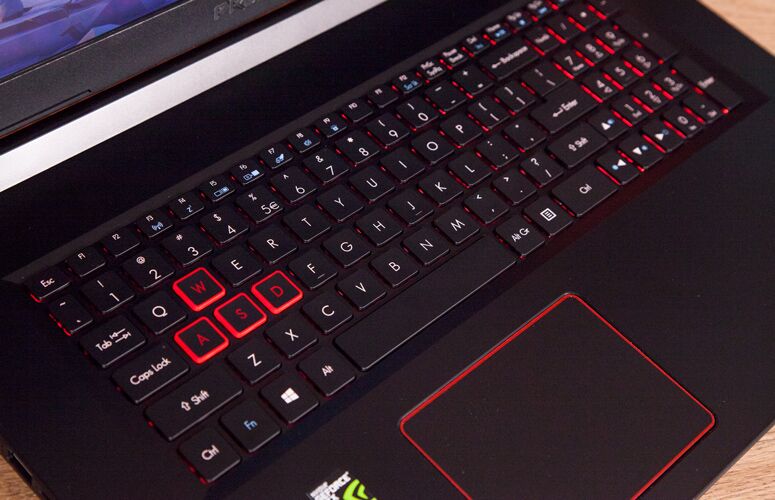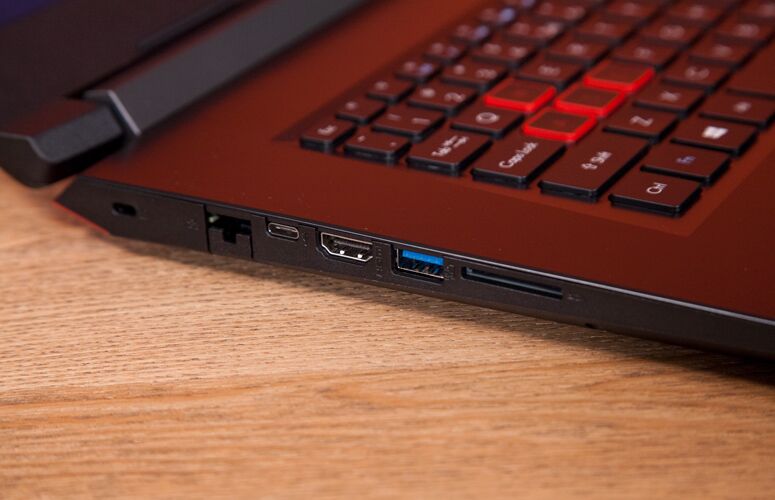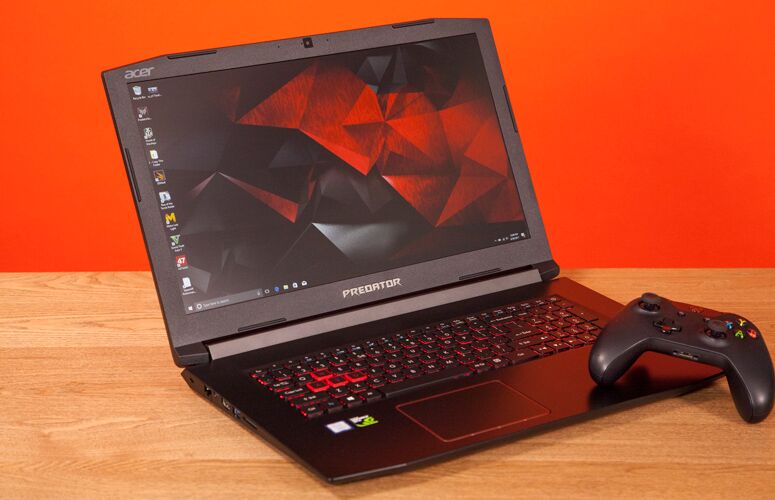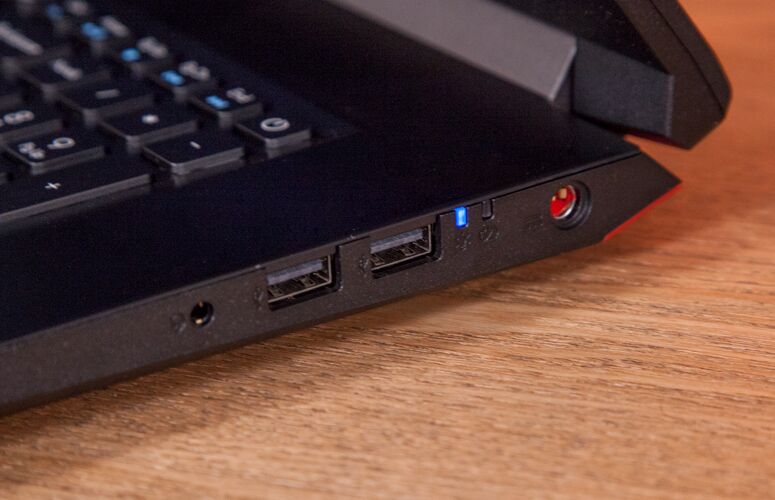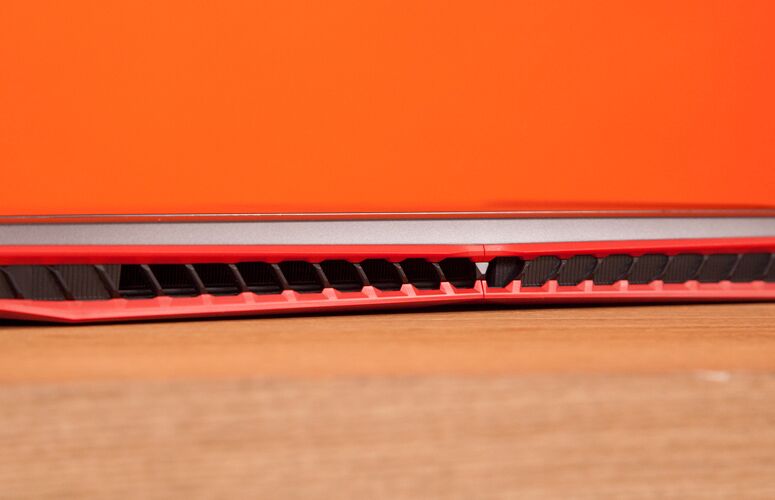Laptop Mag Verdict
The Acer Predator Helios 300 is a powerful, relatively affordable machine with easily upgradable parts.
Pros
- +
Easily upgradable
- +
Strong performance
- +
Vivid display
Cons
- -
Uncomfortable touchpad
- -
Give in the lid
Why you can trust Laptop Mag
When choosing between a gaming desktop or a laptop, one of the notebook's biggest disadvantages has been the lack of upgradability.The Acer Predator Helios 300 bucks this trend, thanks to special doors that grant access to the RAM and hard drive. Its large, 1080p display is bright enough to make you want to ditch your desktop monitor, and the GTX 1060 GPU is powerful enough to run any game you want and even some VR experiences. The Predator's biggest ding is in its construction, including a lid you can press down on and a crunchy touchpad. But for the price, you're getting one heck of a performer.
Design
The Predator's design is much like Acer's other gaming notebooks: black with a red stripe on each side of the Predator logo. The lid is made of black plastic that has a bit of give when you press down on it. That's a shame, because the 15-inch version we reviewed had a metal lid.
Opening the lid reveals the 17.3-inch, 1080p display framed by a thick bezel with both the Predator logo in its usual spot on the bottom and Acer's own logo on the top left. Just like in its other gaming notebooks, Acer really needs to ditch this second logo and let the Predator logo stand alone. You never see an Asus logo on an ROG computer or a Dell logo on an Alienware machine.
The island-style keyboard has red backlighting and red WASD keys, and the deck, unlike the lid, is made of stable, black metal.
The Predator is 6.6 pounds and 17 x 11.4 x 1.1 inches, which is heavier than its competitors. The MSI GP72VR 7RFX Leopard Pro is 6.4 pounds and 16.5 x 10.6 x 1.5 inches, and the Asus ROG Strix GL753VE is 6.4 pounds and 16.4 x 10.7 x 1.3 inches.
MORE: Best Laptops for College Students
Sign up to receive The Snapshot, a free special dispatch from Laptop Mag, in your inbox.
The sides of the laptop are lined with a wide variety of ports to plug in external hard drives, peripherals and monitors. On the left are a Kensington lock slot, an Ethernet port, a USB 3.0 port, an HDMI output, a USB 3.0 port and an SD card reader. The right is sparser: just the headphone jack, a pair of USB 2.0 ports and the power jack.
If you want to upgrade your laptop in the future, you're in luck. Acer makes it easy with two doors on the bottom of the laptop, each held in with a single screw. One allows access to the hard drive, while the other makes it easy to swap in more RAM.
Display
The 17.3-inch, 1080p display on the Predator is nice and bright, with solid colors. When I watched the trailer for Molly's Game, the green poker tables were so vivid I felt like I was in a Vegas casino. And the details were so sharp that I could make out every sequin on Jessica Chastain's dress. When I played Mass Effect: Andromeda, I could see my alien enemies even in a dark cavern in their base, and the blue skies on foreign planets were bright and clear.
The Predator's screen covers 139 percent of the sRGB color gamut, beating out the desktop-replacement average (129 percent) and the Strix (124 percent). It wasn't as vivid as the Leopard Pro's 165 percent, however.
Acer's screen is far brighter than similar notebooks at an average 373 nits on our light meter. The average is 291 nits, and both the Strix (285 nits) and the Leopard Pro (245 nits) were even dimmer.
Keyboard and Touchpad
The Predator's keyboard has a deep 1.6 millimeters of travel, but it doesn't feel as snappy as I like. It requires 70 grams of actuation to press down, which resulted in a comfortable keystroke that didn't pop up fast enough, which could be an issue for gaming. On the 10fastfingers.com typing test, I reached 107 words per minute, my usual average, but with a 4 percent error rate (twice what I usually get wrong). Other laptops in this price range, like the Strix, have keyboards with full RGB backlighting, so it's disappointing to see Acer settle exclusively for red. The WASD keys are highlighted in red, which is a nice touch, but being able to pick any color I want with the backlight would be even nicer. Although I appreciate that Acer jammed a number pad on here, the arrow keys and right shift key are way too close together, and it's easy to hit the wrong one.
The 4 x 3-inch touchpad is generally responsive to gestures, like swiping three fingers up to show all open programs or tapping four fingers to show the Action Center, but it didn't always cooperate when I tried to summon Cortana with a three-finger tap. Clicking felt horrible, as if there was some barrier blocking the touchpad. It made a crunching sound, like someone spilled some granola beneath the plastic. It's really unpleasant.
Audio
If there's one thing to say about the Predator's speakers, it's that they're nice and loud. When I listened to Dua Lipa's "New Rules," the song immediately filled our lab with clear vocals, guitars, drums and horns, though the bass was hard to make out.
When I played Mass Effect: Andromeda, it was similarly loud and clear. While the synth music played in the background, I could make out every gunshot and my team's comments on the radio comms. The computer comes with Dolby Audio software pre-installed, which includes presets for gaming, movies and music. I found that music, the default setting, consistently sounded the best. I recommend leaving it there.
Gaming, Graphics and VR
With an overclockable Nvidia GeForce GTX 1060 GPU and 6GB of dedicated memory, the Predator can deliver fast, smooth gameplay and decent VR experiences. When I booted up Mass Effect Andromeda, the game ran at 60 frames per second flat at 1080p and Ultra settings as Ryder and his crew battled alien forces to take over their base. On the Rise of the Tomb Raider benchmark (1080p, Very High), the Predator chugged along at 59 fps, surpassing the desktop-replacement average (52 fps), the Leopard Pro (33 fps, GTX 1060) and the Strix (22 fps, GTX 1050 Ti).
It performed well on Hitman (1080p, Ultra), too, rendering the game at a smooth 66 fps, beating out the Strix (40 fps) but falling behind the Leopard Pro (78 fps) and the average (81 fps).
The Predator ran Grand Theft Auto V (1080p, Very High) at 73 fps, which is faster than the average (70 fps), the Leopard Pro (48 fps) and the Strix (28 fps).
If you want to upgrade your laptop in the future, you're in luck.
The Predator earned a score of 7.7 on the Steam VR performance test, beating the Leopard Pro (7.1) but falling short of the average (9.3).
Performance
Our configuration of the Predator came armed with a 2.8-GHz Intel Core i7-7700HQ CPU, 16GB of RAM and a 512GB M.2 SATA SSD. That's plenty of power for multitasking. I had 30 tabs open in Chrome, including an episode of Last Week Tonight with John Oliver streaming in 1080p, all without any lag.
On the Geekbench 4 overall performance test, the Predator earned a score of 14,305, beating out the desktop-replacement average (13,212), the Leopard Pro (13,665, i7-7700HQ) and the Strix (13,693, i7-7700HQ).
The touchpad made a crunching sound, like someone spilled some granola beneath the plastic. It's really unpleasant.
It took the Predator 16 seconds to transfer 4.97GB of files, which translates to a rate of 318.1 megabytes per second. The average (494.5MBps) is quicker, as is the Leopard Pro (565.5MBps). The Strix, however, wasn't as fast as the Predator, at just 221.3MBps.
The Predator competed the OpenOffice Spreadsheet test, pairing 20,000 names and addresses, in 3 minutes and 19 seconds. That ties the Strix (3:19), and is just ahead of the average and the Leopard Pro, both at 3:24.
Battery Life
As far as gaming notebooks go, the Predator lasts a decent amount of time on a charge. It endured for 5:36 on the Laptop Mag Battery Test, which browses the web continuously over Wi-Fi. That's more than an hour longer than the desktop-replacement average (4:23), more than twice as long as the Leopard Pro (2:32), but just a tad longer than the Strix (5:25).
Heat
During regular use, the Predator stayed nice and cool, thanks in part to its metal Aeroblade 3D fan and five heat pipes. After streaming 15 minutes of HD video from YouTube, the Predator measured 91 degrees Fahrenheit on the bottom, 89 degrees between the G and H keys and 79 degrees on the touchpad, all well below our 95-degree comfort threshold.
When gaming, though, the Predator still gets toasty. While playing Mass Effect: Andromeda it reached 118 degrees on the underside, 109 degrees at the center of the keyboard and 75 degrees on the touchpad.
Webcam
The 720p webcam on the Predator takes dark photos, so consider your lighting before snapping any headshots or, better yet, invest in an external webcam.
When I took a shot while sitting at my desk, I was covered in shadow, and my royal blue shirt appeared far darker than in real life.
Software and Warranty
Thankfully, Acer didn't load down the Predator with as much bloatware as it tends to on its consumer notebooks. The only significant junk the company added is the Acer Collection, a storefront promotion of free and paid content from partners, and the game World of Warships. The rest of the bloatware is stuff you find in every Windows 10 laptop, such as Keeper, Candy Crush Soda Saga, Bubble Witch 3 Saga, March of Empires: War of Lords, Twitter, Drawboard PDF and Minecraft: Windows 10 Edition.
Acer's most useful application is PredatorSense, a gaming-centric utility that allows for custom control of the fans, temperature monitoring and easy GPU overclocking.
MORE: The Best Headsets for Immersive Gaming
The Predator Helios 300 comes with a two-year warranty. See how Acer performed in our Tech Support Showdown and Best and Worst Gaming Laptop Brands ranking.
Configurations
Our Predator Helios 300 cost $1,299 and came with a 2.8-GHz Intel Core i7-7700HQ CPU, 16GB of RAM, an overclockable Nvidia GeForce GTX 1060 GPU with 6GB of VRAM and a 512GB M.2 SATA SSD.
For $1,349, you get the same specs, except for a 1TB HDD and 256GB SSD. For $1,279, the storage consists of a 1TB HDD and 128GB SSD.
Bottom Line
The 17-inch Acer Predator Helios 300 is an easily upgradable gaming laptop with a bright screen and strong performance, thanks to its overclockable GTX 1060 GPU.
There are some downsides, though. The Leopard Pro has faster transfer speeds due to speedier SSDs, but it also costs an extra $300 compared with the Predator. While I wish the Predator had a better touchpad, for gaming, I'm going to be using a mouse, anyway. If you're looking for strong gaming performance, entry-level VR capability and a great display and sound, the Predator Helios 300 is a solid buy at a decent price.
Credit: Shaun Lucas/Laptop Mag
Acer Predator Helios 300 (17-inch) Specs
| Bluetooth | Bluetooth 4.1 |
| Brand | Acer |
| CPU | 2.8-GHz Intel Core i7-7700HQ processor |
| Card Slots | SD memory reader |
| Company Website | www.acer.com |
| Display Size | 17.3 |
| Graphics Card | Nvidia GeForce GTX 1060/Intel HD 630 Graphics |
| Hard Drive Size | 512GB |
| Hard Drive Speed | n/a |
| Hard Drive Type | SSD |
| Highest Available Resolution | 1920 x 1080 |
| Native Resolution | 1920x1080 |
| Operating System | Windows 10 Home |
| Optical Drive | None |
| Optical Drive Speed | n/a |
| Ports (excluding USB) | HDMI, Headphone/Mic, Kensington Lock, USB 3.0, USB Type-C, Ethernet |
| RAM | 16GB |
| RAM Upgradable to | 32GB |
| Size | 17 x 11.4 x 1.1 inches |
| Touchpad Size | 4 x 3 inches |
| Video Memory | 6GB |
| Warranty/Support | 2-year parts and labor |
| Weight | 6.6 pounds |
| Wi-Fi | 802.11ac |
Andrew is a contributing writer at Laptop Mag. His main focus lies in helpful how-to guides and laptop reviews, including Asus, Microsoft Surface, Samsung Chromebook, and Dell. He has also dabbled in peripherals, including webcams and docking stations. His work has also appeared in Tom's Hardware, Tom's Guide, PCMag, Kotaku, and Complex. He fondly remembers his first computer: a Gateway that still lives in a spare room in his parents' home, albeit without an internet connection. When he’s not writing about tech, you can find him playing video games, checking social media and waiting for the next Marvel movie.
